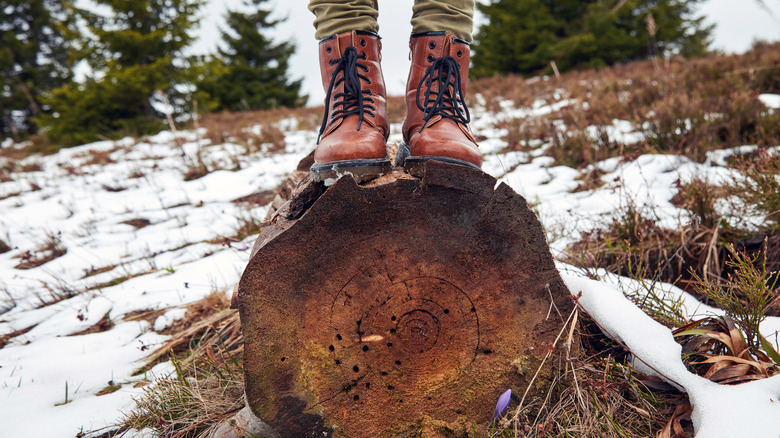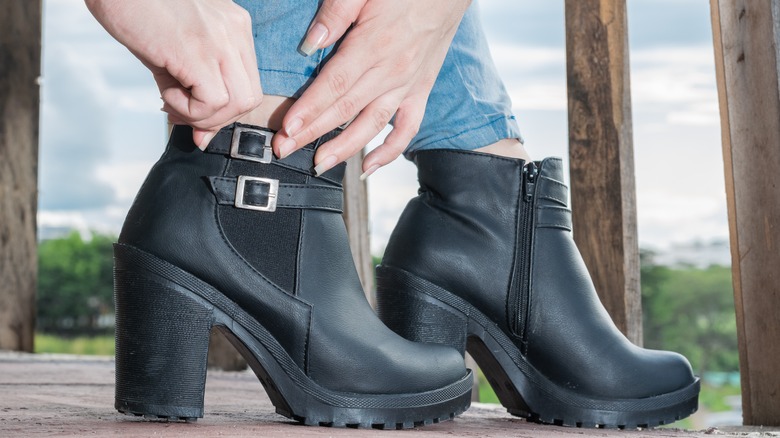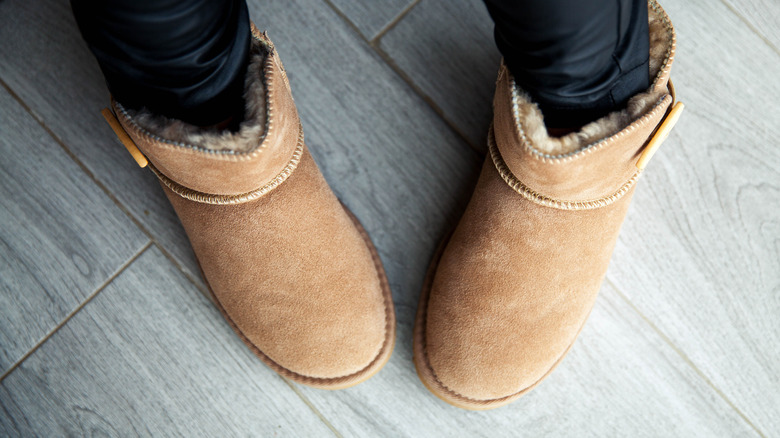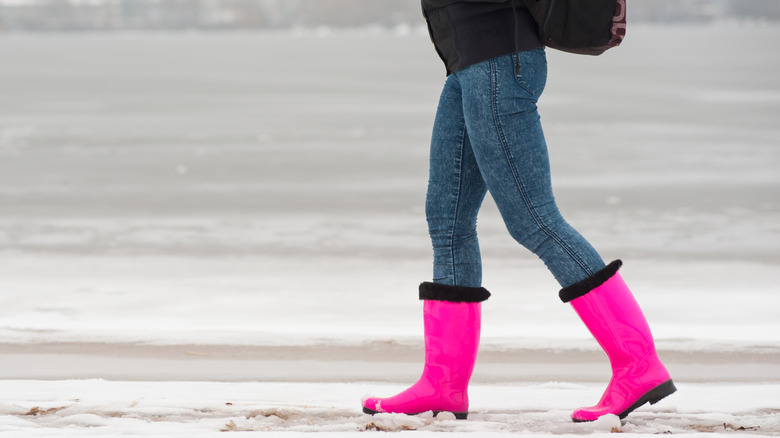What To Do If Your Shoes End Up Stained From Road Salt This Winter
Get out your SAD lights because deep winter has arrived. The middle of winter is a time of cold temperatures, snow, ice, and constant darkness that evokes dread in many. From the effects of months without sunlight on your mental health to the harsh, drying effect cold winter air can have on your skin, nails, and hair, January and February encapsulate the most difficult season of the year for many people.
To add insult to injury, the winter can also take a devastating toll on your favorite shoes and boots. This is thanks to the salts used to melt ice on public sidewalks and streets to prevent accidents and injuries. If you've ever noticed white, crusty rings forming around the bottom of your leather boots, you've likely fallen victim to this phenomenon. While leaving this staining can lead to permanent damage, it's easier than you'd ever guess to remove it before it wreaks havoc on your footwear. Here's how to rid your shoes and boots of road salt stains using an ingredient you probably already have in your kitchen.
Leather
Leather, as a natural material, is particularly vulnerable to damage from dryness. When exposed to salt, leather can become so dry that it can actually crack. This type of damage can be prevented but it cannot be repaired once it has occurred. All leather should be conditioned with a high-quality leather conditioner on a regular basis — and year-round. During winter, frequently check your leather shoes and boots for white salt stains or deposits.
When you spot salt residue on your leather footwear, remove it promptly. There is no reason to purchase a specialized cleaning product for the purpose of removing road salt. Simply grab a jug of distilled white vinegar and mix a couple of tablespoons into an equal amount of water in a small bowl or spray bottle. Since white vinegar contains acetic acid, it can gently dissolve mineral deposits. Dab or spray the vinegar mixture onto the boots or shoes and buff away the staining with a soft cloth. When the stains have been removed, wet a second cloth and wipe away the residual vinegar. Let the leather dry, and then condition it as usual.
Vegan leather
Whether you're opposed to animal products or just opposed to the high price of genuine leather, there's a good chance you might own a pair of faux leather boots or shoes. Unfortunately, even vegan leather can be damaged by road salt deposits, resulting in peeling or premature aging. Once again, a mixture of equal parts distilled white vinegar and water can come to the rescue.
Add a few tablespoons of vinegar with a few tablespoons of water into a spray bottle. Thoroughly wet the affected area of the boots or shoes and let the mixture sit for a few moments. Then, scrub away the salt stains and deposits with a soft cloth or brush. When you're happy with the cleanliness of the faux leather, wipe the boots with a cloth dampened with plain water. Allow them to air dry and then buff in a thin layer of leather conditioner or coconut oil to prevent future drying.
Suede
Removing road salt stains from suede is very similar to removing them from leather. However, since suede is made from the underside of an animal hide, it's a bit more delicate than leather, which is made from the rougher outer portion (via Steel Horse Leather). Unlike leather, suede should never be conditioned or intentionally exposed to excess moisture. Unfortunately, the material becomes easily stained and stretched when wet.
If your suede shoes have collected salt deposits, you'll need to gather a soft brush and distilled white vinegar to reverse the staining. You can purchase a brush designed for cleaning suede or simply use an old toothbrush. Your goal is to expose the suede to as little moisture as possible, so start by using the brush to gently remove as many dry salt deposits as you can. Then, mix a couple of tablespoons of white vinegar with an equal amount of water in a small bowl. Do not use a spray bottle, as you want to minimize the suede's contact with the liquid. Dip a soft cloth into the mixture until it dampens and then work quickly to buff away the staining. Dry the shoes with a soft, dry cloth, and then use the brush to remove any remaining deposits.
Rubber
Rubber can also be cleaned using a diluted white vinegar mixture. In addition to the crusty white deposits that can be left behind by road salt on your rubber boots, you might notice white spots resembling powder, known as blooms (via BOYD). Blooms occur naturally in rubber and can be removed at the same time as salt staining by simply adding one additional step. In order to remove both, mix equal parts white vinegar and water in a spray bottle.
Spray your rubber boots with the vinegar mixture, then vigorously rub away the staining with a clean cloth or brush. When the salt deposits have been completely removed, only the blooms will remain. At this point, apply a small amount of cooking oil to a second cloth. Use the oil to buff out the blooms. Once the blooms have disappeared, use a dry area of the cloth to rub the oil into the boots until they feel dry to the touch, as detailed by The Southern Thing.
Ultimately, no matter what type of boots you rock this winter, white vinegar has your back.




